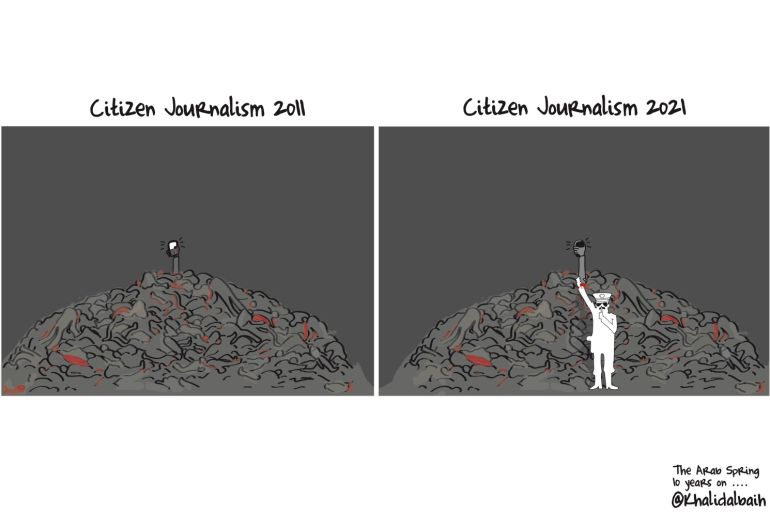Arab Spring Cartoon: Citizen Journalism from Syria to Sudan
What can we learn from the failures and successes of revolutions in the Arab world over the last 10 years?

In 2011, Khalid Albaih’s cartoons about the Arab Spring went viral across the Middle East and North Africa. In this series for Al Jazeera, he revisits some of his work, reflecting on the difference the last decade has made for people in the region.
At the beginning of the Syrian revolution in 2011, one thing dominated the news: grainy mobile phone footage shot by anonymous citizen journalists.
Keep reading
list of 3 itemsCartoon: Winds of change, from Arab Spring to winter
Arab Spring Cartoon: The Libyan Game
The internet, and a new recognition of citizen journalism, had changed the dynamic of who controls the narrative. Out on the front lines, ordinary people were risking their lives to show the world the reality on the ground that was sometimes hard for even journalists to access.
This is what the first #khartoon posted here was about when I drew it 10 years ago.
During the first months of Syria’s Arab Spring, it was primarily videos of protesters, men and women, doing the traditional Dabke dance in the streets that dominated news coverage and appeared on Facebook walls.
Then, the more videos that emerged, the more shares there were, which led to more coverage in the international media, which mobilised people in the West, which in turn motivated Western politicians to act – mostly in search of votes.
But as the years progressed and instability escalated, videos from both sides started to get more violent. The media replaced the term “Syrian revolution” with “Syrian civil war”. And with it, the videos being shared changed from Dabkes to HD beheadings of ISIL (ISIS) captives and to refugees on boats heading to Europe. This saw a rise in xenophobia in Western countries, with politicians joining in the anti-immigration wave as a tactic to get votes – maybe even the same votes.
Ordinary videos, citizen journalists, and Syria itself disappeared altogether from the news cycle. Meanwhile, the powers-that-be in the region capitalised on the power citizen journalism had created by mobilising seas of trolls to drown out or dilute the narrative around the conflict – not only in Syria but across the region and the world.
As a political cartoonist, I consider myself an avid consumer of news and an activist for the region’s issues. But I have not seen or read any main news stories about Syria for a while. Does that mean that the violence has stopped? Or is it not enough violence to make it onto the news? Did citizen journalists stop filming? Or is it just that the Western audience is no longer interested in Syria, that it has exceeded the world’s attention span?
This takes me to Sudan where, in 2011, riding the wave of the Arab Spring, people took to the streets to protest for the first time, and where two years later in 2013 more than 200 people were shot dead by the Janjaweed, an armed militia group whose leader Mohammed Hamdan Dagalo, commonly known as Hemeti, is now ironically the deputy leader of Sudan’s transitional government.
Most of the world did not hear about these killings in Sudan because it was not televised. When citizen journalists tried to contact the international media, their replies were mostly that there was not enough TV-worthy footage coming out of Sudan to warrant a report. No videos meant no news – the opposite of what was going on in Syria at the time.
Cut to 2019 – with almost all the Arab Spring uprisings overtaken by counter-revolutions, pro-government trolls invading social media, and fake news on the rise – Sudan saw more protests. Using nearly 10 years of Arab Spring news experience, Sudanese citizen journalists took to the streets armed with an eye for fake news and trolls, catchy hashtags, and HD mobile footage they knew would touch the hearts of Westerners and celebrities around the world.
Soon #BlueforSudan went viral; by the power vested in Rihanna’s tweets and the Sudanese diaspora, who put pressure on their local politicians, garnering international attention and a shift in regional political alliances. The stars had aligned and with it came the salvation of the Sudanese people after 30 years of the Omar al-Bashir regime.
For the past two years, the story of Sudan’s revolution has also started disappearing from news cycles. But journalists and citizen journalists on the ground are pushing back, keeping the momentum of truth alive by discussing real topics on national TV or trying to create new independent outlets like Sudan Bukra TV.
Whether in Syria or Sudan or elsewhere in the Arab world, the lesson for activists and citizen journalists is to not just depend on social media – where trolls and false information roams free – but to work to control and promote the true narrative, and to be innovative and creative in delivering it.
That is what we can learn from the failures of 2011 and 2013, and from Sudan’s success in 2019.
Rest in peace to all who lost their lives trying to deliver the voice of the unseen.
The views expressed in this article are the author’s own and do not necessarily reflect Al Jazeera’s editorial stance.
